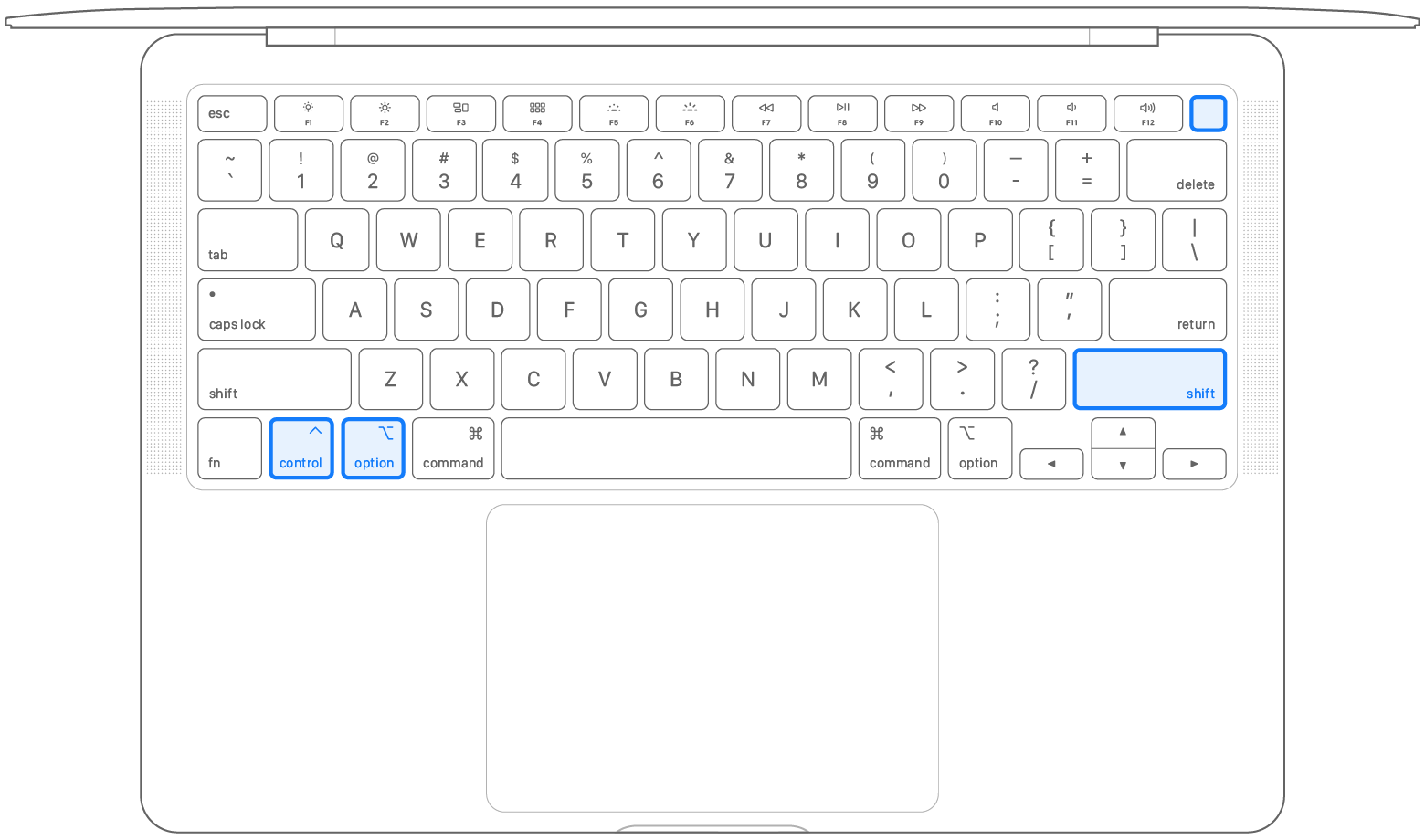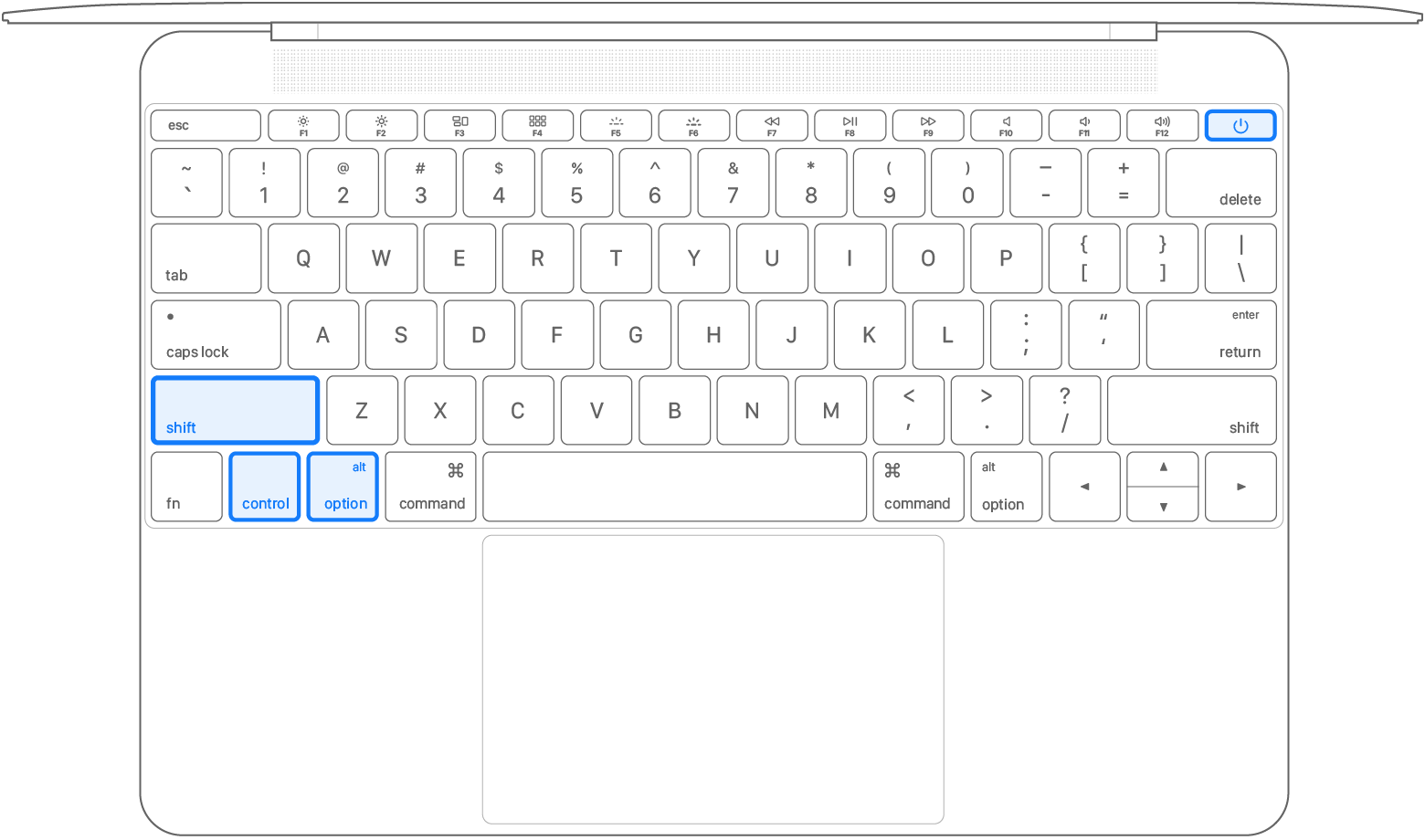Apple SMC Reset
Reset the SMC on computers that have the T2 chip
If your Mac has the Apple T2 Security Chip, follow the steps below, based on your Mac model.
Notebook computers with the T2 chip
Before resetting the SMC, try these steps:
- Shut down your Mac.
- Press and hold the power button for 10 seconds, then release the button.
- Wait a few seconds, then press the power button to turn on your Mac.
If the issue persists, follow these steps to reset the SMC:
- Shut down your Mac.
- On your built-in keyboard, press and hold all of the following keys. Your Mac might turn on.
- Control
 on the left side of your keyboard
on the left side of your keyboard - Option (Alt)
 on the left side of your keyboard
on the left side of your keyboard - Shift
 on the right side of your keyboard
on the right side of your keyboard
- Control
- Keep holding all three keys for 7 seconds, then press and hold the power button as well. If your Mac is on, it will turn off as you hold the keys.

- Keep holding all four keys for another 7 seconds, then release them.
- Wait a few seconds, then press the power button to turn on your Mac.
Desktop computers with the T2 chip
- Shut down your Mac, then unplug the power cord.
- Wait 15 seconds, then plug the power cord back in.
- Wait 5 seconds, then press the power button to turn on your Mac.
Reset the SMC on other computers
If your Mac doesn't have the Apple T2 Security Chip, follow these steps.
Notebook computers with a nonremovable battery
This applies to MacBook Pro models introduced in mid-2009 through 2017, MacBook Air models introduced in 2017 or earlier, and all MacBook models except the MacBook (13-inch, Mid 2009).
- Shut down your Mac.
- On your built-in keyboard, press and hold all of these keys:
- Shift
 on the left side of your keyboard
on the left side of your keyboard - Control
 on the left side of your keyboard
on the left side of your keyboard - Option (Alt)
 on the left side of your keyboard
on the left side of your keyboard
- Shift
- While holding all three keys, press and hold the power button as well.

- Keep holding all four keys for 10 seconds.
- Release all keys, then press the power button to turn on your Mac.
Notebook computers with a battery that can be removed
This applies to all MacBook Pro and MacBook models introduced in early 2009 or earlier, as well as the MacBook (13-inch, Mid 2009).
- Shut down your Mac.
- Remove the battery. (If you need help removing it, contact an Apple Store or Apple Authorized Service Provider.)
- Press and hold the power button for 5 seconds.
- Reinstall the battery.
- Press the power button to turn on your Mac.
Desktop computers
- Shut down your Mac, then unplug the power cord.
- Wait 15 seconds, then plug the power cord back in.
- Wait 5 seconds, then press the power button to turn on your Mac.
Related Articles
Backing up to Google Drive using Drive for Desktop.
Please note, these are one time back-ups and are not synced. Open Google Chrome. If you haven't already, make sure you are logged into your museumca.org account. Go to drive.google.com Click "My Drive" (It shouldn't matter, this is just to be safe) ...Webex Support Documentation
OMCA uses TPX as our phone provider. They us Webex as there mobile phone app. The phone app can be loaded on a smartphone or on a computer. These linked documents provide instructions on how to use the app. Webex Sign In Webex Search Webex Quick ...What Are Domain Credentials?
You may have heard us frequently refer to the use of "Domain Credentials" when logging into computers or accessing shared resources. You may have even asked yourself "What ARE Domain Credentials anyway?" Here's an explanation for you. Your Domain ...How Kandji Updates Work
Kandji downloads needed updates prior to installing them, sometimes days ahead! These updates "sit there" until they are manually or automatically installed. If updates are delayed beyond their install deadline, you will need to restart the computer ...Single Sign On - Duo
OMCA has adopted Duo as our Single Sign-On provider What is DUO? Duo Single Sign-On (SSO) is a cloud-hosted single sign-on solution (SSO) solution which can act as a Security Assertion Markup Language (SAML) 2.0 identity provider or OpenID Connect ...